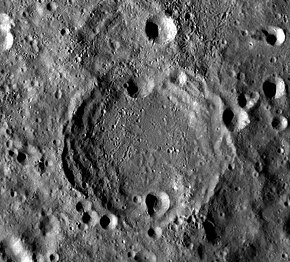
LRO WAC image | |
| Coordinates | 17°18′N 165°36′W / 17.3°N 165.6°W |
|---|---|
| Diameter | 86 km |
| Depth | unknown |
| Colongitude | 167° at sunrise |
| Eponym |
Francis C. McMath Robert R. McMath |
McMath is an impact crater on the Moon's far side. It lies to the south-southwest of the prominent crater Jackson, and material from the ray system centered on Jackson lies across most of McMath. Farther to the south lies the crater pair of Zhukovskiy and Lebedinskiy.
This is a worn, torn up, and eroded crater formation with several small craters along the rim edge. The rim is the most heavily worn at the northern end, but is more intact to the east and west. The interior floor is relatively level, and is marked by only a few tiny craterlets.
McMath lies to the northwest of the Dirichlet-Jackson Basin.
Satellite craters
By convention these features are identified on lunar maps by placing the letter on the side of the crater midpoint that is closest to McMath.
| McMath | Latitude | Longitude | Diameter |
|---|---|---|---|
| A | 19.2° N | 165.3° W | 15 km |
| J | 14.8° N | 163.3° W | 36 km |
| M | 16.1° N | 165.5° W | 15 km |
| P | 13.4° N | 168.6° W | 28 km |
| Q | 14.5° N | 167.7° W | 20 km |
See also
- 1955 McMath, minor planet
References
- Andersson, L. E.; Whitaker, E. A. (1982). NASA Catalogue of Lunar Nomenclature. NASA RP-1097.
- Blue, Jennifer (July 25, 2007). "Gazetteer of Planetary Nomenclature". USGS. Retrieved 2007-08-05.
- Bussey, B.; Spudis, P. (2004). The Clementine Atlas of the Moon. New York: Cambridge University Press. ISBN 978-0-521-81528-4.
- Cocks, Elijah E.; Cocks, Josiah C. (1995). Who's Who on the Moon: A Biographical Dictionary of Lunar Nomenclature. Tudor Publishers. ISBN 978-0-936389-27-1.
- McDowell, Jonathan (July 15, 2007). "Lunar Nomenclature". Jonathan's Space Report. Retrieved 2007-10-24.
- Menzel, D. H.; Minnaert, M.; Levin, B.; Dollfus, A.; Bell, B. (1971). "Report on Lunar Nomenclature by the Working Group of Commission 17 of the IAU". Space Science Reviews. 12 (2): 136–186. Bibcode: 1971SSRv...12..136M. doi: 10.1007/BF00171763. S2CID 122125855.
- Moore, Patrick (2001). On the Moon. Sterling Publishing Co. ISBN 978-0-304-35469-6.
- Price, Fred W. (1988). The Moon Observer's Handbook. Cambridge University Press. ISBN 978-0-521-33500-3.
- Rükl, Antonín (1990). Atlas of the Moon. Kalmbach Books. ISBN 978-0-913135-17-4.
- Webb, Rev. T. W. (1962). Celestial Objects for Common Telescopes (6th revised ed.). Dover. ISBN 978-0-486-20917-3.
- Whitaker, Ewen A. (1999). Mapping and Naming the Moon. Cambridge University Press. ISBN 978-0-521-62248-6.
- Wlasuk, Peter T. (2000). Observing the Moon. Springer. ISBN 978-1-85233-193-1.

LRO WAC image | |
| Coordinates | 17°18′N 165°36′W / 17.3°N 165.6°W |
|---|---|
| Diameter | 86 km |
| Depth | unknown |
| Colongitude | 167° at sunrise |
| Eponym |
Francis C. McMath Robert R. McMath |
McMath is an impact crater on the Moon's far side. It lies to the south-southwest of the prominent crater Jackson, and material from the ray system centered on Jackson lies across most of McMath. Farther to the south lies the crater pair of Zhukovskiy and Lebedinskiy.
This is a worn, torn up, and eroded crater formation with several small craters along the rim edge. The rim is the most heavily worn at the northern end, but is more intact to the east and west. The interior floor is relatively level, and is marked by only a few tiny craterlets.
McMath lies to the northwest of the Dirichlet-Jackson Basin.
Satellite craters
By convention these features are identified on lunar maps by placing the letter on the side of the crater midpoint that is closest to McMath.
| McMath | Latitude | Longitude | Diameter |
|---|---|---|---|
| A | 19.2° N | 165.3° W | 15 km |
| J | 14.8° N | 163.3° W | 36 km |
| M | 16.1° N | 165.5° W | 15 km |
| P | 13.4° N | 168.6° W | 28 km |
| Q | 14.5° N | 167.7° W | 20 km |
See also
- 1955 McMath, minor planet
References
- Andersson, L. E.; Whitaker, E. A. (1982). NASA Catalogue of Lunar Nomenclature. NASA RP-1097.
- Blue, Jennifer (July 25, 2007). "Gazetteer of Planetary Nomenclature". USGS. Retrieved 2007-08-05.
- Bussey, B.; Spudis, P. (2004). The Clementine Atlas of the Moon. New York: Cambridge University Press. ISBN 978-0-521-81528-4.
- Cocks, Elijah E.; Cocks, Josiah C. (1995). Who's Who on the Moon: A Biographical Dictionary of Lunar Nomenclature. Tudor Publishers. ISBN 978-0-936389-27-1.
- McDowell, Jonathan (July 15, 2007). "Lunar Nomenclature". Jonathan's Space Report. Retrieved 2007-10-24.
- Menzel, D. H.; Minnaert, M.; Levin, B.; Dollfus, A.; Bell, B. (1971). "Report on Lunar Nomenclature by the Working Group of Commission 17 of the IAU". Space Science Reviews. 12 (2): 136–186. Bibcode: 1971SSRv...12..136M. doi: 10.1007/BF00171763. S2CID 122125855.
- Moore, Patrick (2001). On the Moon. Sterling Publishing Co. ISBN 978-0-304-35469-6.
- Price, Fred W. (1988). The Moon Observer's Handbook. Cambridge University Press. ISBN 978-0-521-33500-3.
- Rükl, Antonín (1990). Atlas of the Moon. Kalmbach Books. ISBN 978-0-913135-17-4.
- Webb, Rev. T. W. (1962). Celestial Objects for Common Telescopes (6th revised ed.). Dover. ISBN 978-0-486-20917-3.
- Whitaker, Ewen A. (1999). Mapping and Naming the Moon. Cambridge University Press. ISBN 978-0-521-62248-6.
- Wlasuk, Peter T. (2000). Observing the Moon. Springer. ISBN 978-1-85233-193-1.